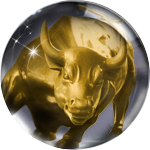Gray bars = predicted
Red/Green bars = actual
Blue line = mid point of predicted
( HINT: Click-and-drag left-to-right on a chart to zoom in to a specific date range. Double-click on a chart to zoom back out. )
Can machine learning be used to predict the stock market?
Welcome to The Machine™, an advanced machine learning algorithm we built to try to predict tomorrow's trading range (High & Low). We have invested a lot of time in developing this algorithm, and have much more work still to do. But, we believe this algorithm may give a slight edge, so we decided to publish for those stock market students who may be curious.
Are there patterns in stock prices that tend to repeat? Behavioral sciences tell us, "Yes, most likely". But, is the best way to discover these patterns to have humans studying millions of charts looking for similarities? That answer is, unequivocally, "No!"
Through machine learning, complex (and most likely invisible to the eye) patterns can be found via a process of piecemeal curve fitting. Using complex linear algebra with large matrices and deep layers, a modern computer can tweak parameters to find the best fit to almost any optimum curve. Such an optimum curve should discover previously unknown patterns, and also even well-known patterns, such as a cross of moving averages, a change in trend, or even cups-with-handles, double-bottoms, heads-and-shoulders, or many other popularly-used chart patterns. While simultaneously adjusting for prevailing sentiment values, earnings, volatility, risk, money supply, and other factors, a machine can perform a multi-human-year study in hours.
Study each candle's Close (if market is open, rightmost candle shows current quote). If the mid-point of the next day's range is higher than the previous Close, then the model is expecting higher prices the next day, and a chance to sell at a higher price. Conversely, if the mid-point of the next day's range is lower than the previous Close, the model is expecting lower prices the next day, and to exercise caution.
We invite you to follow along as we continue to train our model to try to add a meaningful edge to investors. WARNING: This is highly experimental, so trade at your own risk!
Feel free to share with others who may be interested. As always, we welcome your comments.

